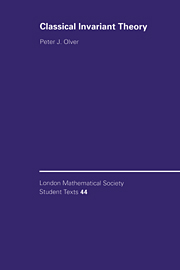Book contents
- Frontmatter
- Contents
- Introduction
- 1 Prelude — Quadratic Polynomials and Quadratic Forms
- 2 Basic Invariant Theory for Binary Forms
- 3 Groups and Transformations
- 4 Representations and Invariants
- 5 Transvectants
- 6 Symbolic Methods
- 7 Graphical Methods
- 8 Lie Groups and Moving Frames
- 9 Infinitesimal Methods
- 10 Multivariate Polynomials
- References
- Author Index
- Subiect Index
8 - Lie Groups and Moving Frames
Published online by Cambridge University Press: 08 January 2010
- Frontmatter
- Contents
- Introduction
- 1 Prelude — Quadratic Polynomials and Quadratic Forms
- 2 Basic Invariant Theory for Binary Forms
- 3 Groups and Transformations
- 4 Representations and Invariants
- 5 Transvectants
- 6 Symbolic Methods
- 7 Graphical Methods
- 8 Lie Groups and Moving Frames
- 9 Infinitesimal Methods
- 10 Multivariate Polynomials
- References
- Author Index
- Subiect Index
Summary
So far, the methods that have been introduced for analyzing the invariants of binary forms have been essentially algebraic in nature and, apart from being geared towards the group of linear transformations in the plane (or projective transformations on the line), are also, in principle, applicable to quite general group actions. We have not yet exploited the additional analytical structure of such matrix groups, which has no counterpart in the realm of finite or discrete groups. Namely, the group elements depend analytically on parameters, and hence the group comes equipped with a topology — notions of open and closed sets, convergence, and so on — as well as a differentiable structure, enabling one to apply powerful calculus-based tools that are not available in the purely discrete framework. The resulting combination of group theory and analysis has a remarkable synergy, enabling one to effectively and efficiently deal with a wide range of practical group-theoretic issues.
In this chapter, we begin with a brief survey of the basic theory of matrix Lie groups, emphasizing the general linear group as the prototypical example. We shall assume the reader is familiar with the basics of multivariable calculus, and we will be a bit less systematic in our inclusion of proofs of main results. The interested reader can find all of the relevant details in standard texts on Lie groups, e.g., [169, 173, 227]. This chapter includes several innovations that are inspired by new extensions, [69, 70], of the Cartan theory of moving frames, cf. [33, 93, 95], arising in the basic geometry of curves and surfaces.
- Type
- Chapter
- Information
- Classical Invariant Theory , pp. 150 - 197Publisher: Cambridge University PressPrint publication year: 1999



